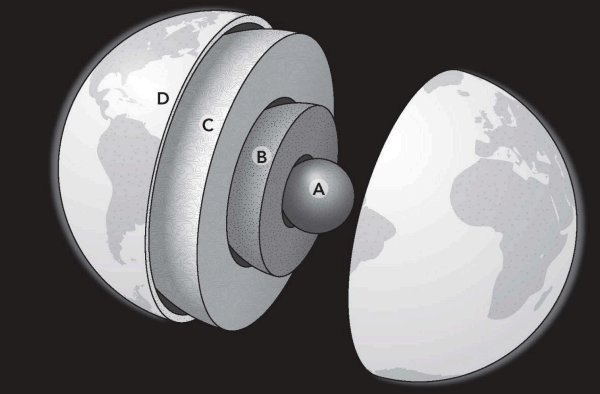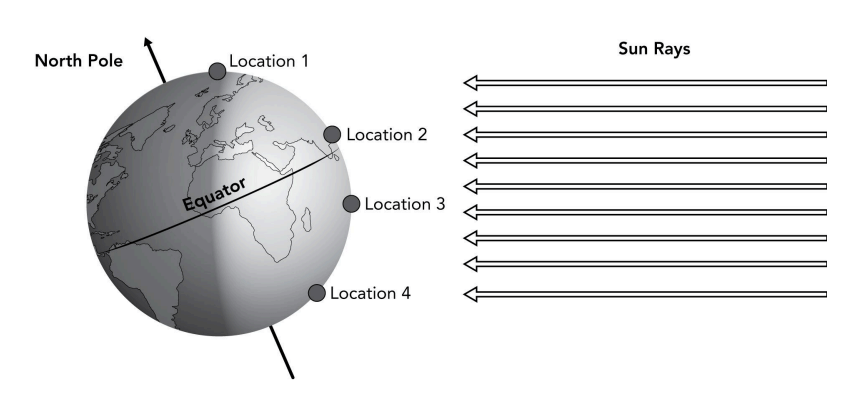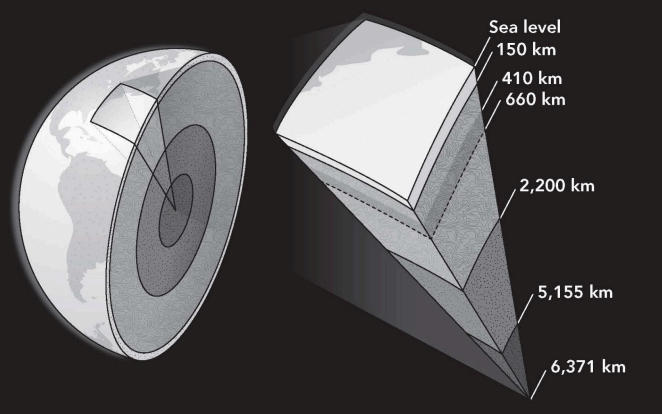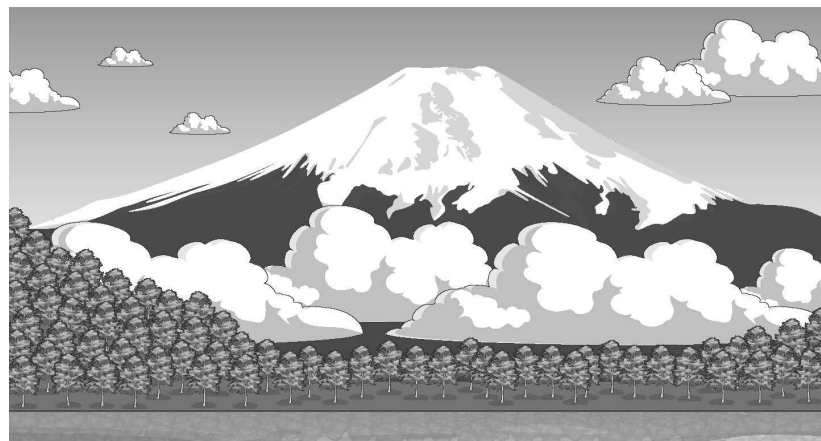A Texas scientist is researching climate in Buenos Aires, Argentina, which is located in the Southern Hemisphere. On the first day of their research, the scientist observes that the sun rises at 8:00 am and sets at 5:50 pm. There is daylight for less than 10 hours. On which of the following dates did the scientist most likely begin their research?
March 21
June 21
September 21
December 21
June 21st
The gravitational pull of the moon has a _____ impact on Earth’s ocean tides than the gravitational pull of the sun because the sun is ______ Earth.
Choose the terms that best complete the sentences.
greater; farther from
greater; closer to
lesser; larger than
lesser; smaller than
greater; farther from
How does the hydrosphere differ from the biosphere?
A. The hydrosphere is composed of Earth’s water, which is nonliving, while the biosphere is composed of living things.
B. Both the hydrosphere and biosphere are composed of living things on Earth.
C. Both the hydrosphere and biosphere are composed of nonliving things on Earth.
D. The biosphere is only composed of living things that live in the hydrosphere.
A. The hydrosphere is composed of Earth’s water, which is nonliving, while the biosphere is composed of living things.
The thickest layer of Earth is the ______ which is composed of _______.
Which terms best complete the sentence?
A. mantle; mostly liquid rock containing iron and nickel
B. outer core; mostly liquid rock containing iron and nickel
C. inner core; mostly solid rock containing iron and magnesium
D. mantle; mostly solid rock containing iron and magnesium
D. mantle; mostly solid rock containing iron and magnesium
In the rock cycle, what type of rock is formed from magma and what processes lead to the formation of this rock type?
A. Metamorphic; due to compaction and cementation
B. Igneous; due to heating and cooling
C. Sedimentary; due to heating and cooling
D. Igneous; due to weathering and erosion
B. Igneous; due to heating and cooling
Which of the following does not affect the seasons on Earth?
A. The Earth’s revolution around the sun
B. The tilt of Earth’s axis of rotation
C. The moon’s revolution around Earth
D. The changing distance between Earth and the sun
C. The moon’s revolution around Earth
The effect of gravitational force on tides in Earth’s oceans is stronger when the _____ are ______ . The result is referred to as______ .
Choose the terms that best complete the sentences.
A. moon and Earth; not aligned; a spring tide
B. sun and Earth; aligned; a spring tide
C. sun and moon; aligned; a spring tide
D. sun and moon; not aligned; a neap tide
C. sun and moon; aligned; a spring tide
Earth’s atmosphere contains which of the following components?
A. All forms of water, including solid, liquid, and water vapor
B. Rocks and minerals
C. A gaseous mixture of nitrogen, oxygen, and other gases
D. All living things found on Earth
C. A gaseous mixture of nitrogen, oxygen, and other gases
Naomi is developing a model of Earth’s interior layers, as shown.

Which option labels Earth’s layers correctly from A to D.
A. Inner core; outer core; mantle; crust
B. Crust; outer core; mantle; inner core
C. Outer core; inner core; crust; mantle
D. Mantle; crust; inner core; outer core
A. Inner core; outer core; mantle; crust
Granite is an igneous rock, but it can change and form limestone, a sedimentary rock. Which processes allow granite to undergo this change?
A. Heat and pressure from Earth’s core
B. Rock melting into magma and cooling
C. Compaction and cementation of sediment formed from weathered rock.
D. Melted rock deposited into layers
C. Compaction and cementation of sediment formed from weathered rock.

Based on the diagram _______, is receiving the most direct sunlight because it is angled _______ the sun. Choose the terms that best complete the sentence.
A. Location 1; toward
B. Location 2; away from
C. Location 3; toward
D. Location 4; away from
C. Location 3; toward
Suppose that Earth keeps rotating and revolving just as it does now, but the moon takes twice as long to revolve around Earth. Predict how this would affect the frequency of Earth's tides.
A. Daily tides would occur twice per day, but spring and neap tides would not occur.
B. Daily tides would not occur, but spring and neap tides would occur half as frequently.
C. Daily tides would occur twice per day, but spring and neap tides would occur half as frequently.
D. Daily, spring, and neap tides would not occur.
C. Daily tides would occur twice per day, but spring and neap tides would occur half as frequently.
Which two statements are true of Earth’s hydrosphere?
A. Water in the hydrosphere is found in oceans, glaciers, rivers, and lakes.
B. The hydrosphere contains only salt water and does not include fresh water.
C. Water on Earth can be found in different forms, such as ice, liquid, and vapor.
D. Small bodies of water, such as ponds, are not part of the hydrosphere.
A. Water in the hydrosphere is found in oceans, glaciers, rivers, and lakes.
C. Water on Earth can be found in different forms, such as ice, liquid, and vapor.
The temperature and thickness of Earth’s layers differ significantly between layers. The layer with the highest temperature is the ______. The layer with the lowest temperature, which is also the thinnest, is the ______. Which terms, in order, best complete the sentences?
A. outer core; crust
B. outer core; mantle
C. inner core; crust
D. inner core; outer core
C. inner core; crust
Shale is a sedimentary rock, but it can change and form slate, a metamorphic rock,
through which processes?
A. Weathering and erosion
B. Increased heat and pressure
C. Deposition of sediment
D. Cooling and solidification of magma
B. Increased heat and pressure

Based on the diagram______, will experience the longest amount of daylight
because it is closest to the _______ .
Choose the terms that best complete the sentence.
A. Location 1; North Pole
B. Location 2; equator
C. Location 3; sun
D. Location 4; South Pole
D. Location 4; South Pole
You and your friend visit a beach on the California coastline. At 6 am, it is high tide, with the moon directly overhead. Your friend wants to come back to see if they can find any sea stars or crabs in the tide pools that form during low tide. You know there are 2 high and 2 low tides every 24 hours along this coastline.
When do you tell your friend to come back?
A. 12 hours later
B. 4 hours later
C. 8 hours later
D. 6 hours later
D. 6 hours later
Sturgeon, like the ones seen in the image, are commonly found in freshwater in North America.

Pick the terms, in order, that best finish the sentence describing the correct
components from each sphere in the sturgeon’s ecosystem? The rocks in the picture are part of the _____ , but the fish are part of the _______ .
A. hydrosphere; atmosphere
B. biosphere; hydrosphere
C. atmosphere; geosphere
D. geosphere; biosphere
D. geosphere; biosphere
Look at the image.

The layer of Earth that is made up of liquid metal and ends about 5,155 km from Earth’s surface is the _______. This layer is located between the mantle and the ________. Which terms, in order, best complete the sentences?
A. mantle; inner core
B. outer core; inner core
C. mantle; outer core
D. inner core; crust
B. outer core; inner core
Carla visits the Grand Canyon and notices the beautiful multi-layered sedimentary rocks of the canyon walls. Which statement best describes one way the sedimentary rock could have formed in the rock cycle?
A. Heat and pressure changed igneous rock into sedimentary rock.
B. Melting and cooling changed metamorphic rock into sedimentary rock.
C. Weathering and erosion changed metamorphic rock into sediment that was compacted and cemented into sedimentary rock.
D. Cooling changed magma into sediment that was compacted and cemented into sedimentary rock.
C. Weathering and erosion changed metamorphic rock into sediment that was compacted and cemented into sedimentary rock.
Kenny and his family live in Portland, Oregon. When school started in September, Kenny rode his bike to school every day. He always left his house at 7:30 am and always made it to school well before the 8:00 am bell rang. This gave him time to lock his bike and get to class. In late October, Kenny’s science teacher noticed that
Kenny was getting to school just after the bell. He continued to arrive a little later each day. When she asked why he was tardy, he told her that it was too dark in the morning. He would only start riding to school when there was enough light, but everyday the sky got bright later and later.
Kenny’s teacher said she would excuse all his tardies if he could explain why this was happening. Help Kenny by choosing the terms to finish the paragraph below so it correctly explains why the sun is rising later each morning.
The sun is rising later because Earth is entering the part of its orbit where the tilt of its axis keeps the Northern hemisphere pointing ______ the sun. This causes the amount of daylight each day to______ , so the days will be _______.
A. towards; increase; longer
B. towards; decrease; shorter
C. away from; increase; longer
D. away from; decrease; shorter
D. away from; decrease; shorter
Which statements describe a neap tide? Select all that apply.
A. Tide with the greatest difference between high and low tide
B. Earth, sun, and moon aligned
C. Tide with the smallest difference between high and low tide
D. Gravitational forces of the sun and moon on Earth are perpendicular to each other
C. Tide with the smallest difference between high and low tide
D. Gravitational forces of the sun and moon on Earth are perpendicular to each other
Keiko takes a trip to Japan and visits Mt. Fuji, pictured in the image.

Pick the terms, in order, that complete the sentences describing the spheres that Keiko sees at Mt. Fuji.
The volcano is a component of the _______ . The trees are a component of the ________ . The clouds are a component of the _________.
Which terms, in order, best complete the sentences?
A. geosphere; biosphere; hydrosphere
B. hydrosphere; atmosphere; biosphere
C. atmosphere; hydrosphere; geosphere
D. biosphere; hydrosphere; atmosphere
A. geosphere; biosphere; hydrosphere
Isaiah has been learning about Earth’s layers, including the composition and state of
matter of each layer. He knows that the inner core is very hot, yet evidence collected
by geologists suggests it is solid. Which best describes why the inner core is a solid,
despite being so hot?
A. The inner core is hot, but not hot enough to melt the metals found there.
B. The metals found in the inner core are extremely heavy.
C. Pressure from the other layers make the inner core very dense and prevent it from becoming a liquid.
D. The metals in the inner core react with one another to become solid.
C. Pressure from the other layers make the inner core very dense and prevent it from becoming a liquid.
Carla visits the Grand Canyon and notices the beautiful multi-layered sedimentary rocks of the canyon walls.
If the sedimentary rocks are exposed to high heat and pressure, what type of rock would be formed?
A. Intrusive igneous rock
B. Metamorphic rock
C. Extrusive igneous rock
D. Sedimentary rock
B. Metamorphic rock